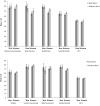Health-Related Quality of Life in Tehran Lipid and Glucose Study
- PMID: 30584433
- PMCID: PMC6289317
- DOI: 10.5812/ijem.84745
Health-Related Quality of Life in Tehran Lipid and Glucose Study
Abstract
Context: Beyond the objective outcomes of metabolic syndrome (MetS), the association between this syndrome and its patient-centered outcomes need to be investigated in Middle-Eastern countries. This report aims to summarize the Tehran lipid and glucose study (TLGS) findings regarding the association between MetS and health-related quality of life (HRQoL) and its influential factors through the past decade.
Evidence acquisition: The current review has been conducted on the TLGS published data regarding different aspects of the association between MetS and HRQoL in adult participants through the last decade. To assess HRQoL, the Iranian version of short form health survey (SF-36) was used. To define MetS the most commonly used insulin resistance (IR)-and waist circumference (WC) - based MetS definitions have been applied in the publications reviewed.
Results: As a whole, MetS was a determinant of poor physical HRQoL only in women (OR: 1.78; 95% CI: 1.21 - 2.61), particularly in those with more component of MetS (P < 0.001). Results further showed that only reproductive aged women with MetS were more likely to report poor PCS compared to those without MetS even after adjusting for age (OR: 1.7, 95% CI: 1.0 - 3.0; P < 0.05). Different structures of MetS and physical HRQoL constructs in men and women as well as age and smoking with significant gender-specific effects on mental HRQoL were factors responsible for the gender specific pattern observed. Considering the duration of MetS, only women with intermittent MetS indicated higher risk for reporting poor PCS (OR: 2.75, 95% CI: 1.19 - 6.37; P < 0.001) compared to those without MetS. The observed sex-specific pattern used to detect poor HRQoL in those with MetS was confirmed by all WC-based definitions except for the American Heart Association/National Heart, Lung, and Blood Institute (AHA/NHLBI) definition. However, none of IR-based definitions could detect poor physical and mental HRQoL in either gender.
Conclusions: In summary, in the TLGS population, the association between MetS and HRQoL followed a sex specific pattern, mainly significant only in women and in the physical aspect.
Keywords: Health-Related Quality of Life; Metabolic Syndrome; TLGS.
Figures




Similar articles
-
Which insulin resistance-based definition of metabolic syndrome has superior diagnostic value in detection of poor health-related quality of life? Cross-sectional findings from Tehran Lipid and Glucose Study.Health Qual Life Outcomes. 2015 Dec 9;13:194. doi: 10.1186/s12955-015-0391-5. Health Qual Life Outcomes. 2015. PMID: 26645669 Free PMC article.
-
Health-related quality of life in adults with metabolic syndrome: a multi-level analysis of family and individual level variation.BMJ Open. 2024 Nov 18;14(11):e087870. doi: 10.1136/bmjopen-2024-087870. BMJ Open. 2024. PMID: 39557558 Free PMC article.
-
Association between Metabolic Syndrome and Health-related Quality of Life among Individuals with Normal and Impaired Glucose Regulation: Findings from Tehran Lipid and Glucose Study.Arch Iran Med. 2016 Aug;19(8):577-83. Arch Iran Med. 2016. PMID: 27544367
-
Metabolic Syndrome: Findings from 20 Years of the Tehran Lipid and Glucose Study.Int J Endocrinol Metab. 2018 Oct 21;16(4 Suppl):e84771. doi: 10.5812/ijem.84771. eCollection 2018 Oct. Int J Endocrinol Metab. 2018. PMID: 30584438 Free PMC article. Review.
-
Symptom burden and health-related quality of life in chronic kidney disease: A global systematic review and meta-analysis.PLoS Med. 2022 Apr 6;19(4):e1003954. doi: 10.1371/journal.pmed.1003954. eCollection 2022 Apr. PLoS Med. 2022. PMID: 35385471 Free PMC article.
Cited by
-
The role of changes in metabolic syndrome status on health-related quality of life in Bogor City, West Java, Indonesia: A cross-sectional study.Belitung Nurs J. 2025 Apr 19;11(2):172-185. doi: 10.33546/bnj.3543. eCollection 2025. Belitung Nurs J. 2025. PMID: 40256385 Free PMC article.
-
Abdominal obesity and hypertension are correlated with health-related quality of life in Taiwanese adults with metabolic syndrome.BMJ Open Diabetes Res Care. 2020 Feb;8(1):e000947. doi: 10.1136/bmjdrc-2019-000947. BMJ Open Diabetes Res Care. 2020. PMID: 32079613 Free PMC article.
-
Contributions and Implications of the Tehran Lipid and Glucose Study.Int J Endocrinol Metab. 2018 Oct 31;16(4 Suppl):e84792. doi: 10.5812/ijem.84792. eCollection 2018 Oct. Int J Endocrinol Metab. 2018. PMID: 30584448 Free PMC article. Review.
References
Publication types
LinkOut - more resources
Full Text Sources
Research Materials
Miscellaneous
